Estimation of Pollutant Emissions in Real Driving Conditions Based on Data from OBD and Machine Learning
Abstract
:1. Introduction
2. Materials and Methods
2.1. Methodology for the Estimation of Emission Gases under Real Driving Conditions
- Real driving and emission data collection;
- Estimation of the selected gear during driving;
- Estimation of the relative importance of each measured variable;
- Training and validation of the neural network with the most significant variables of Route 1 and validation of the ANN calculated by applying on Route 2;
- Application of the data set of 1218.9 km to the validated ANN;
- Processing and presentation of results.
2.2. Driving and Emission Real Data Collection
2.2.1. Test Vehicle
2.2.2. Portable Emission Measurement System PEMS
2.2.3. Data Logger
2.2.4. Test Routes
2.2.5. Estimation of the Selected Gear
2.2.6. Pollutant Estimation
2.3. Estimation of the Relative Importance of Each Measured Variable
2.4. Training and Validation of the Neural Network with the Most Significant Variables of Route 1
2.5. Validation of the ANN with Route 2 Data
2.6. Double Validation of the ANN. Data Set of 1218.9 km
2.7. Processing and Presentation of Results
3. Results and Discussion
4. Conclusions
Author Contributions
Funding
Institutional Review Board Statement
Informed Consent Statement
Data Availability Statement
Conflicts of Interest
References
- Smit, R.; Kingston, P.; Wainwright, D.H.; Tooker, R. A tunnel study to validate motor vehicle emission prediction software in Australia. Atmos. Environ. 2017, 151, 188–199. [Google Scholar] [CrossRef] [Green Version]
- United Nations. The World’s Cities in 2016; United Nations: New York, NY, USA, 2013; Volume 8, pp. 8557–8571.
- Fontaras, G.; Zacharof, N.G.; Ciuffo, B. Fuel consumption and CO2 emissions from passenger cars in Europe—Laboratory versus real-world emissions. Prog. Energy Combust. Sci. 2017, 60, 97–131. [Google Scholar] [CrossRef]
- Ortenzi, F.; Costagliola, M.A. A new method to calculate instantaneous vehicle emissions using OBD data. SAE Tech. Pap. 2010. [Google Scholar] [CrossRef]
- Castermans, J.; Brusselmans, A.; Jean-Pandazis, C. Cooperative Mobility Systems and Services for Energy Efficiency; European Union DG INFSO: Auderghem, Belgium, 2010.
- Tsiakmakis, S.; Fontaras, G.; Dornoff, J.; Valverde, V.; Komnos, D.; Ciuffo, B.; Mock, P.; Samaras, Z. From lab-to-road & vice-versa: Using a simulation-based approach for predicting real-world CO2 emissions. Energy 2019, 169, 1153–1165. [Google Scholar] [CrossRef]
- Lois, D.; Wang, Y.; Boggio-Marzet, A.; Monzon, A. Multivariate analysis of fuel consumption related to eco-driving: Interaction of driving patterns and external factors. Transp. Res. Part D Transp. Environ. 2019, 72, 232–242. [Google Scholar] [CrossRef]
- Samaras, C.; Tsokolis, D.; Toffolo, S.; Magra, G.; Ntziachristos, L.; Samaras, Z. Enhancing average speed emission models to account for congestion impacts in traffic network link-based simulations. Transp. Res. Part D Transp. Environ. 2019, 75, 197–210. [Google Scholar] [CrossRef]
- Prakash, S.; Bodisco, T.A. An investigation into the effect of road gradient and driving style on NOX emissions from a diesel vehicle driven on urban roads. Transp. Res. Part D Transp. Environ. 2019, 72, 220–231. [Google Scholar] [CrossRef]
- Costagliola, M.A.; Costabile, M.; Prati, M.V. Impact of road grade on real driving emissions from two Euro 5 diesel vehicles. Appl. Energy 2018, 231, 586–593. [Google Scholar] [CrossRef]
- Larue, G.S.; Malik, H.; Rakotonirainy, A.; Demmel, S. Fuel consumption and gas emissions of an automatic transmission vehicle following simple eco-driving instructions on urban roads. IET Intell. Transp. Syst. 2014, 8, 590–597. [Google Scholar] [CrossRef] [Green Version]
- Eckert, J.J.; Santiciolli, F.M.; Yamashita, R.Y.; Corrêa, F.C.; Silva, L.C.A.; Dedini, F.G. Fuzzy gear shifting control optimisation to improve vehicle performance, fuel consumption and engine emissions. IET Control. Theory Appl. 2019, 13, 2658–2669. [Google Scholar] [CrossRef]
- Beckx, C.; De Vlieger, I. The influence of gear change on vehicle exhaust emissions. Calculations with the VETSS emission tool. In Proceedings of the International Conference on Urban Air Quality, Limassol, Cyprus, 27–29 March 2007. [Google Scholar]
- Mera, Z.; Fonseca, N.; López, J.M.; Casanova, J. Analysis of the high instantaneous NOx emissions from Euro 6 diesel passenger cars under real driving conditions. Appl. Energy 2019, 242, 1074–1089. [Google Scholar] [CrossRef]
- Brundell-Freij, K.; Ericsson, E. Influence of street characteristics, driver category and car performance on urban driving patterns. Transp. Res. Part D Transp. Environ. 2005, 10, 213–229. [Google Scholar] [CrossRef]
- Ericsson, E. Driving Pattern in Urban. Areas-Descriptive Analysis and Initial Prediction Model; Lunds University, Lunds Tekniska Högskola Institutionen för Teknik och samhälle Avdelning Trafikteknik: Lund, Sweden, 2000; Volumen Bulletin 185. [Google Scholar]
- Boulter, P.G.; Barlow, T.J.; Mccrae, I.S.; Latham, S.; Parkin, C. Emission Factors 2009: Report 1—A Review of Methods for Determining Hot Exhaust Emission Factors for Road Vehicles; TRL: Crowthorne, UK, 2009; Volume 116, p. R353. [Google Scholar]
- Zöldy, M.; Zsombók, I. Modelling fuel consumption and refuelling of autonomous vehicles. MATEC Web Conf. 2018, 235, 6. [Google Scholar] [CrossRef]
- Kurtyka, K.; Pielecha, J. The evaluation of exhaust emission in RDE tests including dynamic driving conditions. Transp. Res. Procedia 2019, 40, 338–345. [Google Scholar] [CrossRef]
- European Commission and Council of the European Union Commission Regulation (EU). 2016/427 of 10 March 2016 amending Regulation (EC) No 692/2008 as regards emissions from light passenger and commercial vehicles (Euro 6) (Text with EEA relevance). Off. J. Eur. Union 2016, 82, 1–98. [Google Scholar]
- Ue, R.; Comisión, D.E.L.A. REGLAMENTO (UE) 2016/427. Por el que se modifica el Reglamento (CE) n.o 692/2008 en lo que concierne a las emisiones procedentes de turismos y vehículos comerciales ligeros (Euro 6). Diario Oficial de la Unión Europea 2016, L 82, 1–98. [Google Scholar]
- Parra, R. Inventario de Emisiones Atmosféricas del Canton Cuenca 2014. Inventario de emisiones atmosféricas del Cantón Cuenca 2016, 76. [Google Scholar] [CrossRef]
- Fujita, E.M.; Campbell, D.E.; Zielinska, B.; Chow, J.C.; Lindhjem, C.E.; DenBleyker, A.; Bishop, G.A.; Schuchmann, B.G.; Stedman, D.H.; Lawson, D.R. Comparison of the MOVES2010a, MOBILE6.2, and EMFAC2007 mobile source emission models with on-road traffic tunnel and remote sensing measurements. J. Air Waste Manag. Assoc. 2012, 62, 1134–1149. [Google Scholar] [CrossRef] [PubMed] [Green Version]
- Asociación de de Empresas Automotrices del Ecuador. In Automotive in Figures; AEADE: Quito, Ecuador, 2018.
- Schafer, R.W. What Is a Savitzky-Golay Filter? [Lecture Notes]. IEEE Signal Process. Mag. 2011, 28, 111–117. [Google Scholar] [CrossRef]
- Strobl, C.; Boulesteix, A.L.; Zeileis, A.; Hothorn, T. Bias in random forest variable importance measures: Illustrations, sources and a solution. BMC Bioinform. 2007, 8. [Google Scholar] [CrossRef] [Green Version]
- Jain, A.K. Data clustering: 50 years beyond K-means. Pattern Recognit. Lett. 2010, 31, 651–666. [Google Scholar] [CrossRef]
- Yasami, Y.; Mozaffari, S.P. A novel unsupervised classification approach for network anomaly detection by k-Means clustering and ID3 decision tree learning methods. J. Supercomput. 2010, 53, 231–245. [Google Scholar] [CrossRef]
- Román de Andres, A.R. Metodológia Para La Asignación De Vehículos De Una Flota a Rutas Preestablecidas. Tesis Doctorall, ETSII, Univesidad Politécnica de Madrid, 2014. Available online: http://oa.upm.es/view/institution/Industriales (accessed on 12 January 2019).
- Van Mierlo, J.; Maggetto, G.; Van De Burgwal, E.; Gense, R. Driving style and traffic measures-Influence on vehicle emissions and fuel consumption. Proc. Inst. Mech. Eng. Part. D J. Automob. Eng. 2004, 218, 43–50. [Google Scholar] [CrossRef]
- Fernandes, P.; Macedo, E.; Bahmankhah, B.; Tomas, R.F.; Bandeira, J.M.; Coelho, M.C. Are internally observable vehicle data good predictors of vehicle emissions? Transp. Res. Part D Transp. Environ. 2019, 77, 252–270. [Google Scholar] [CrossRef]
- Guo, H.; Zhang, Q.-Y.; Shi, Y.; Wang, D.-H. Evaluation of the International Vehicle Emission (IVE) model with on-road remote sensing measurements. J. Environ. Sci. 2007, 19, 818–826. [Google Scholar] [CrossRef]

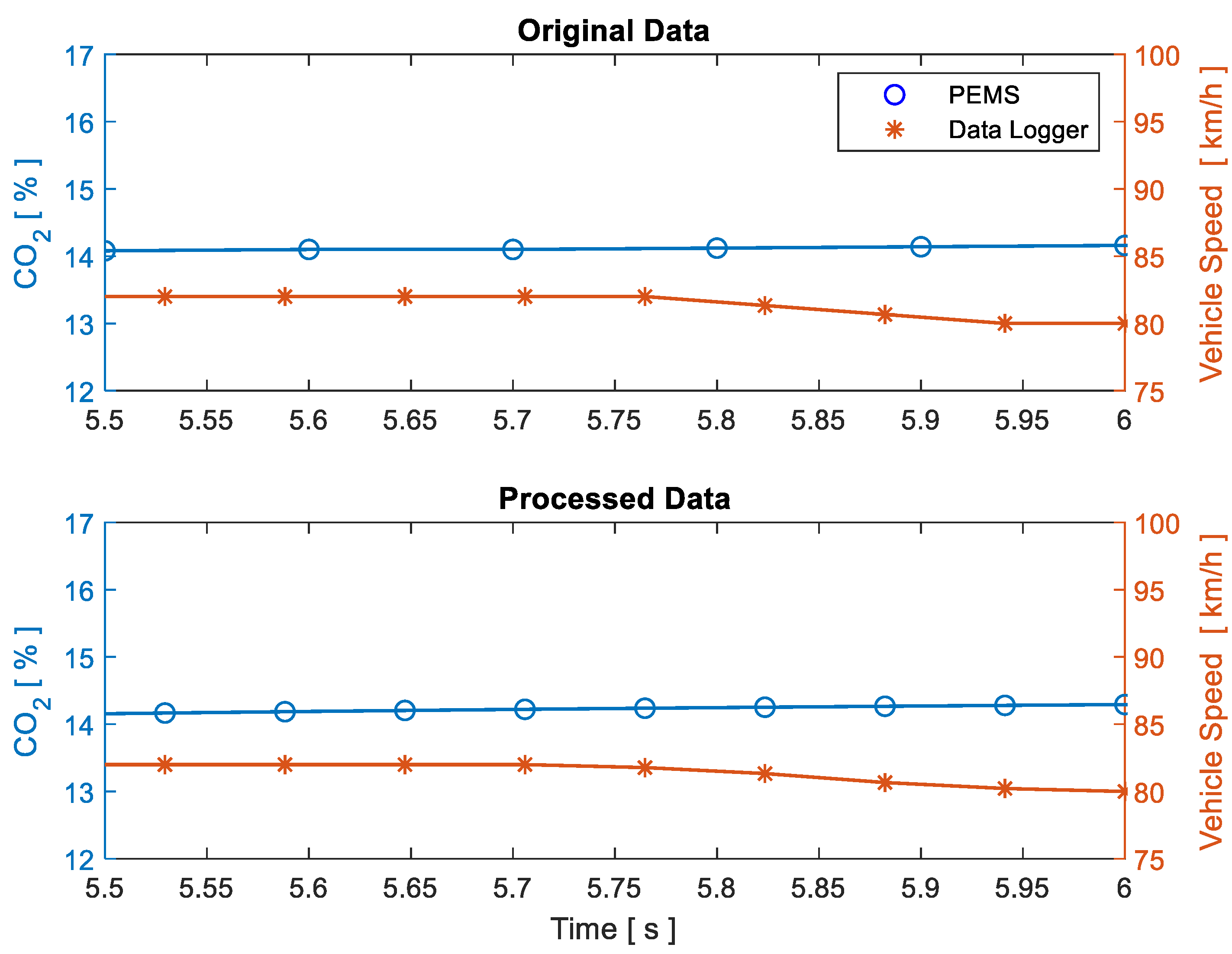
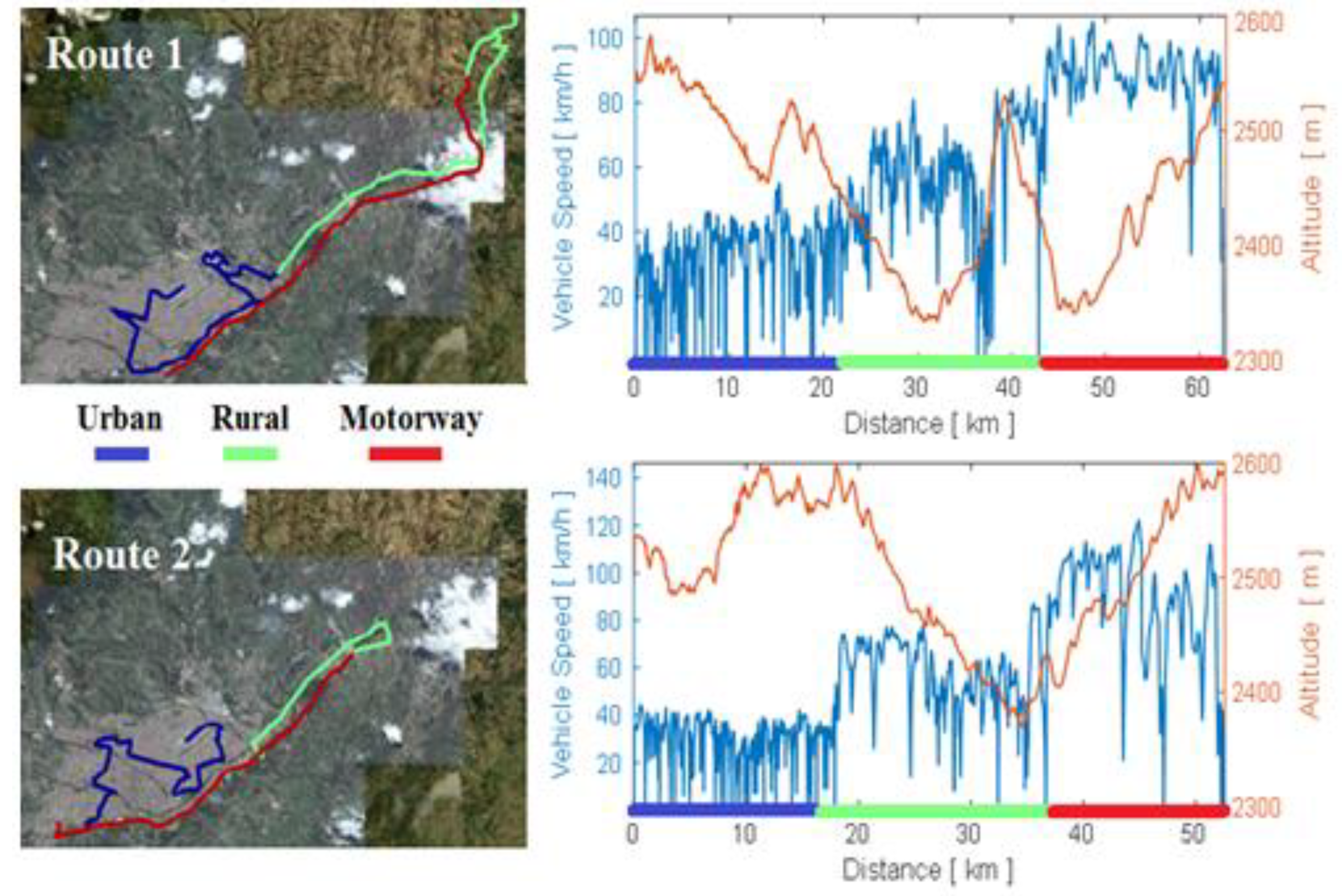
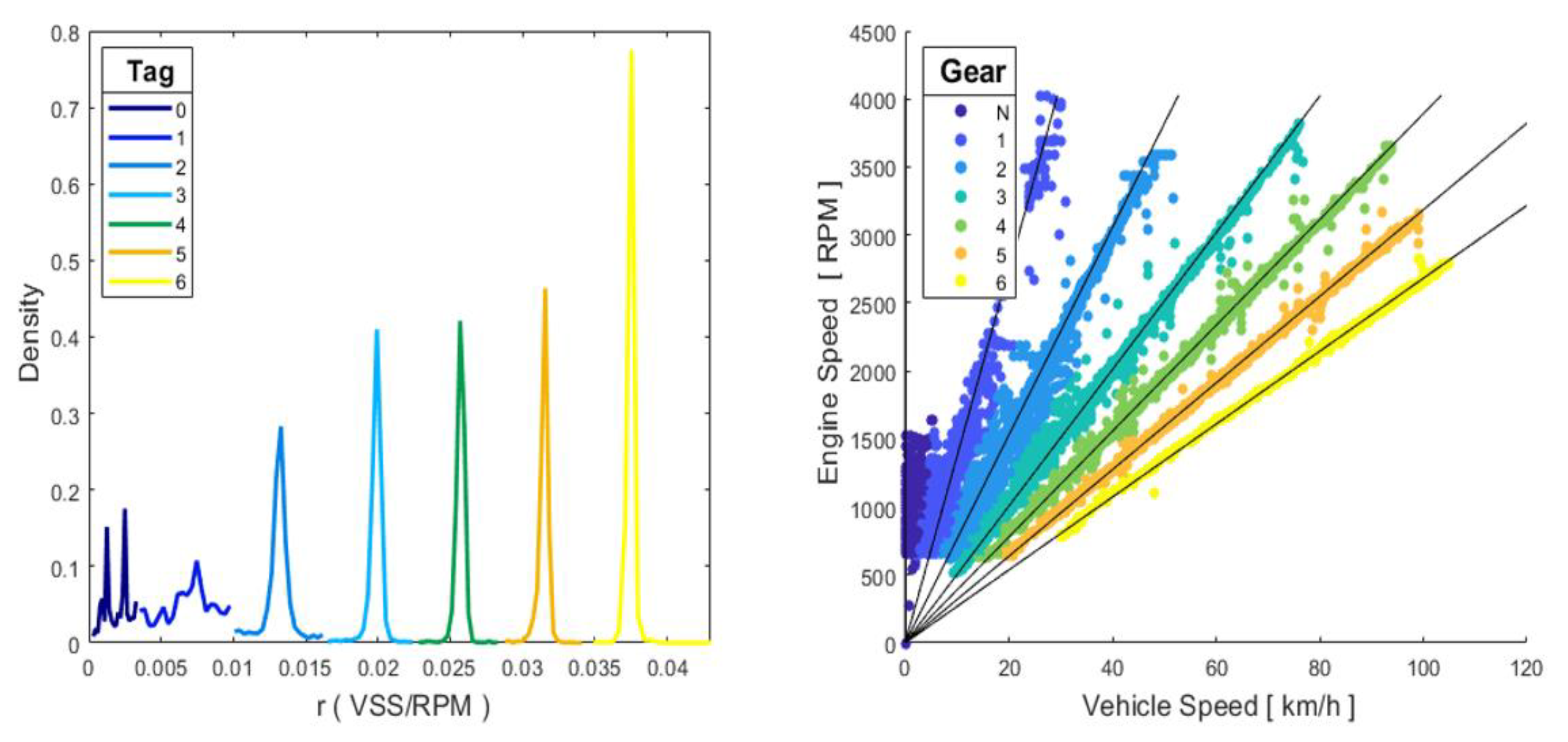

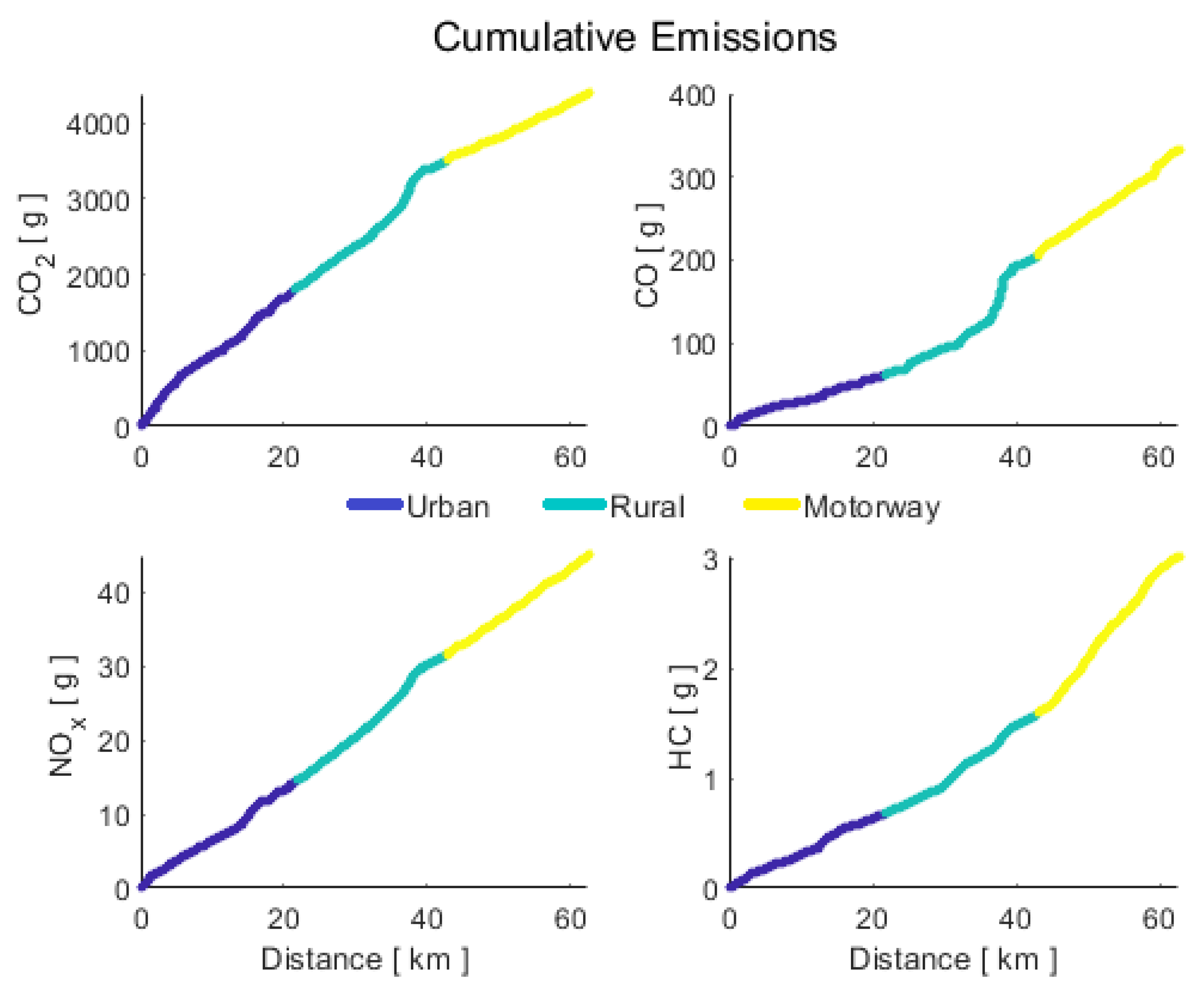
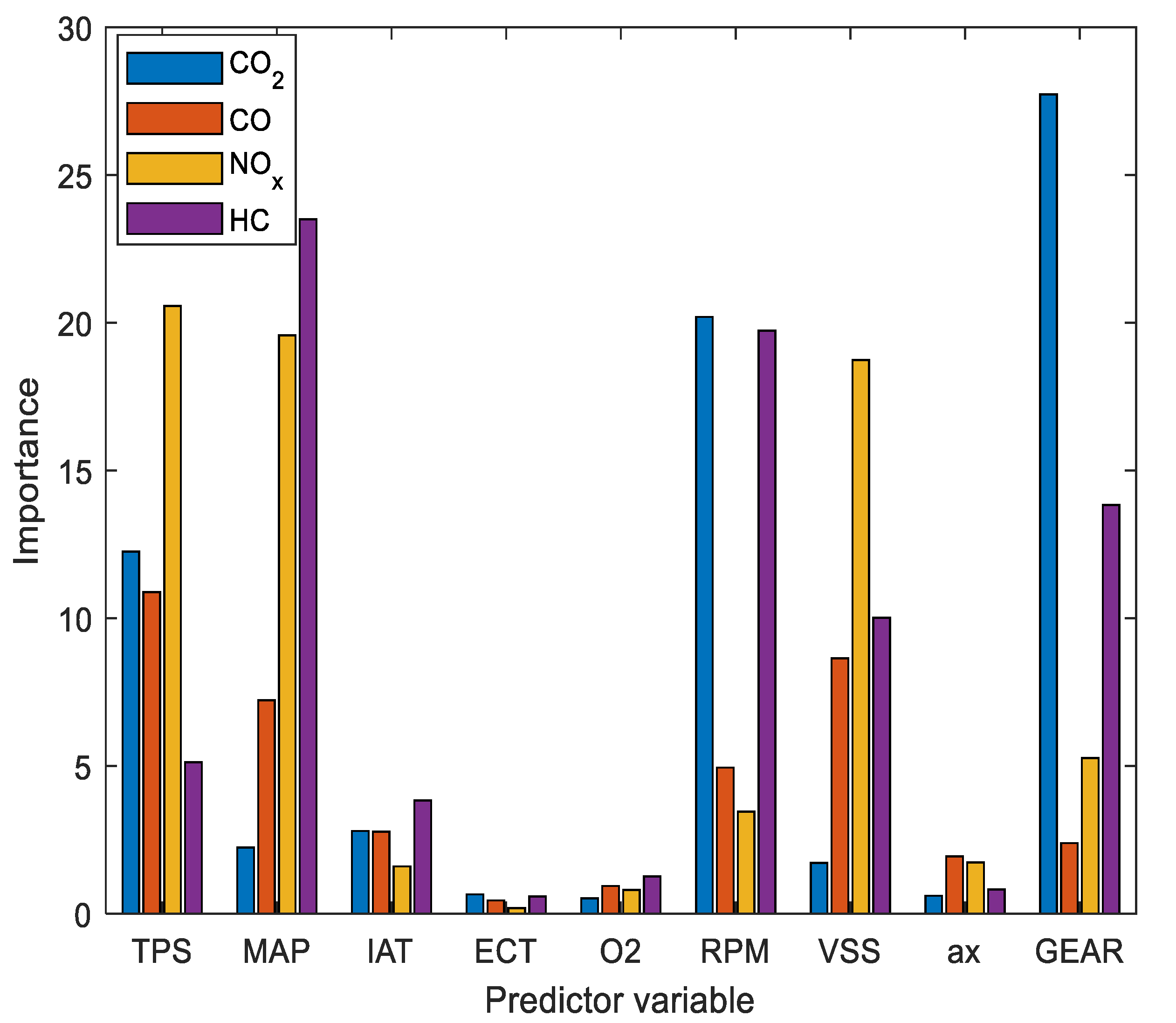
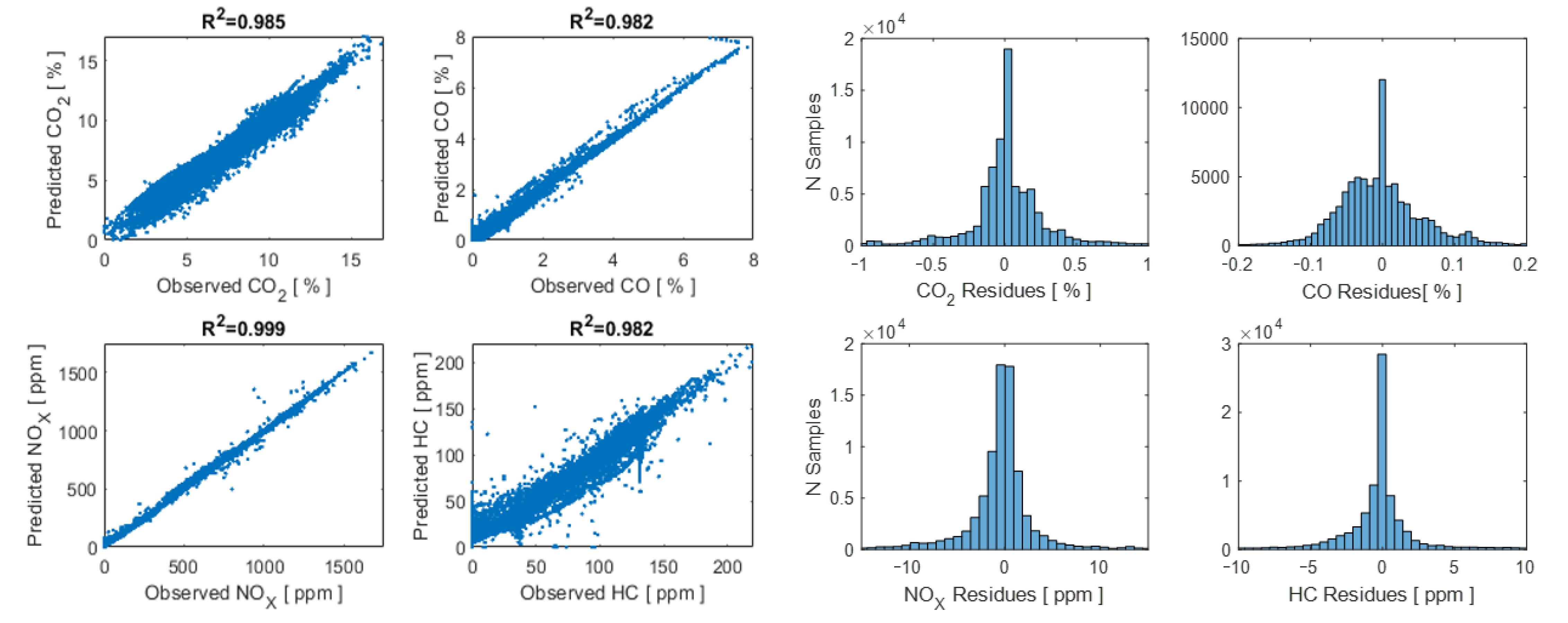
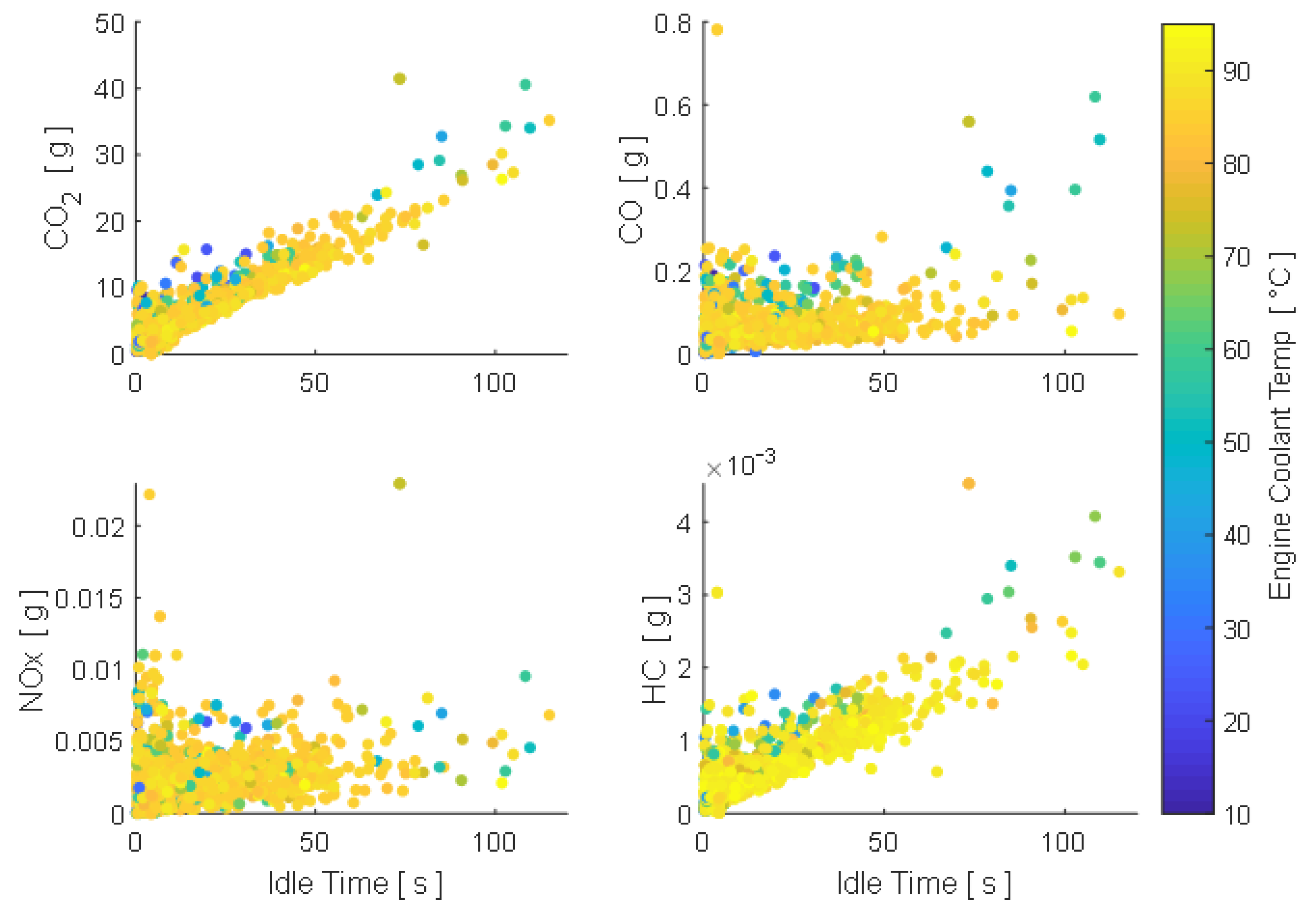
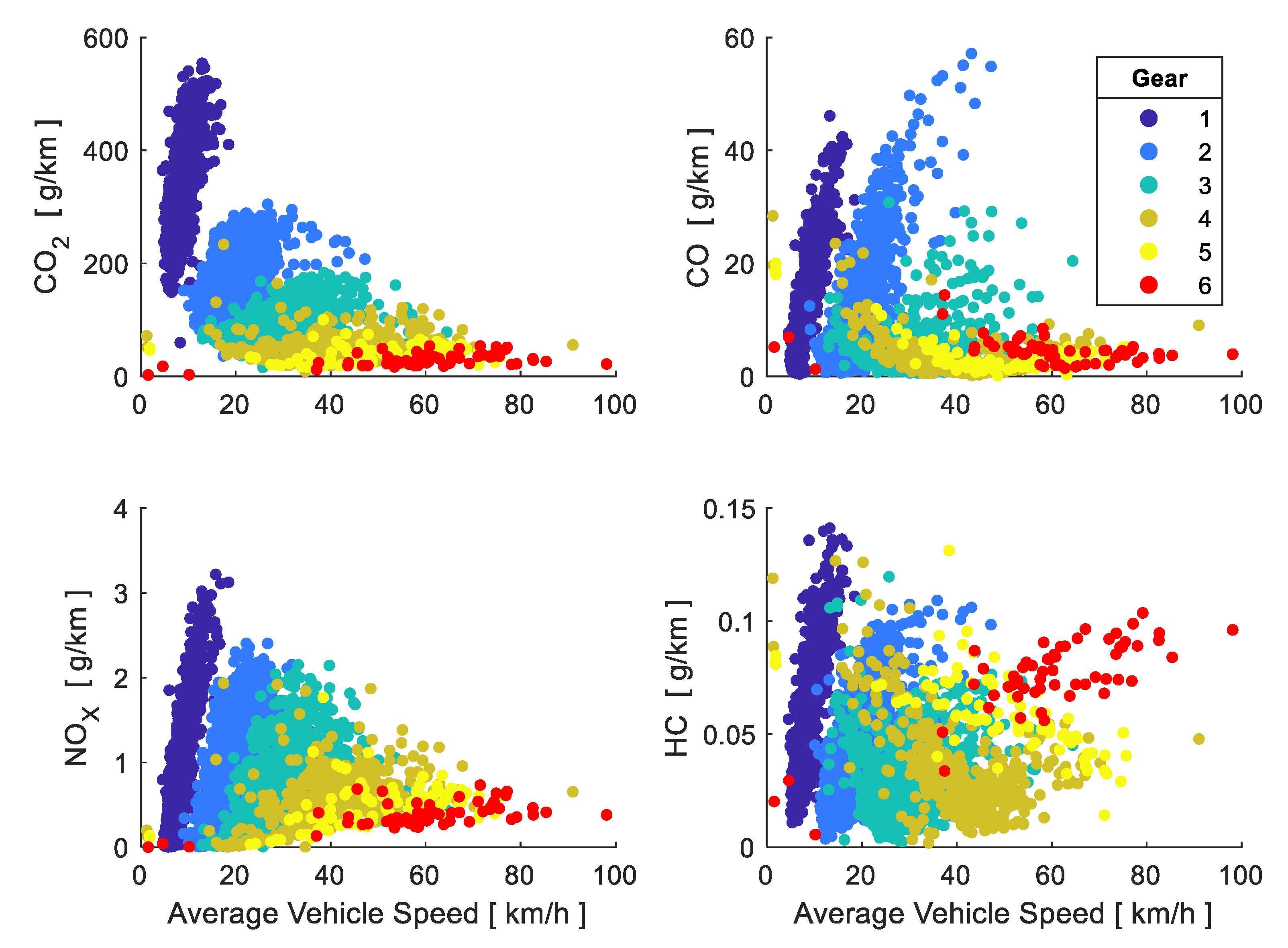
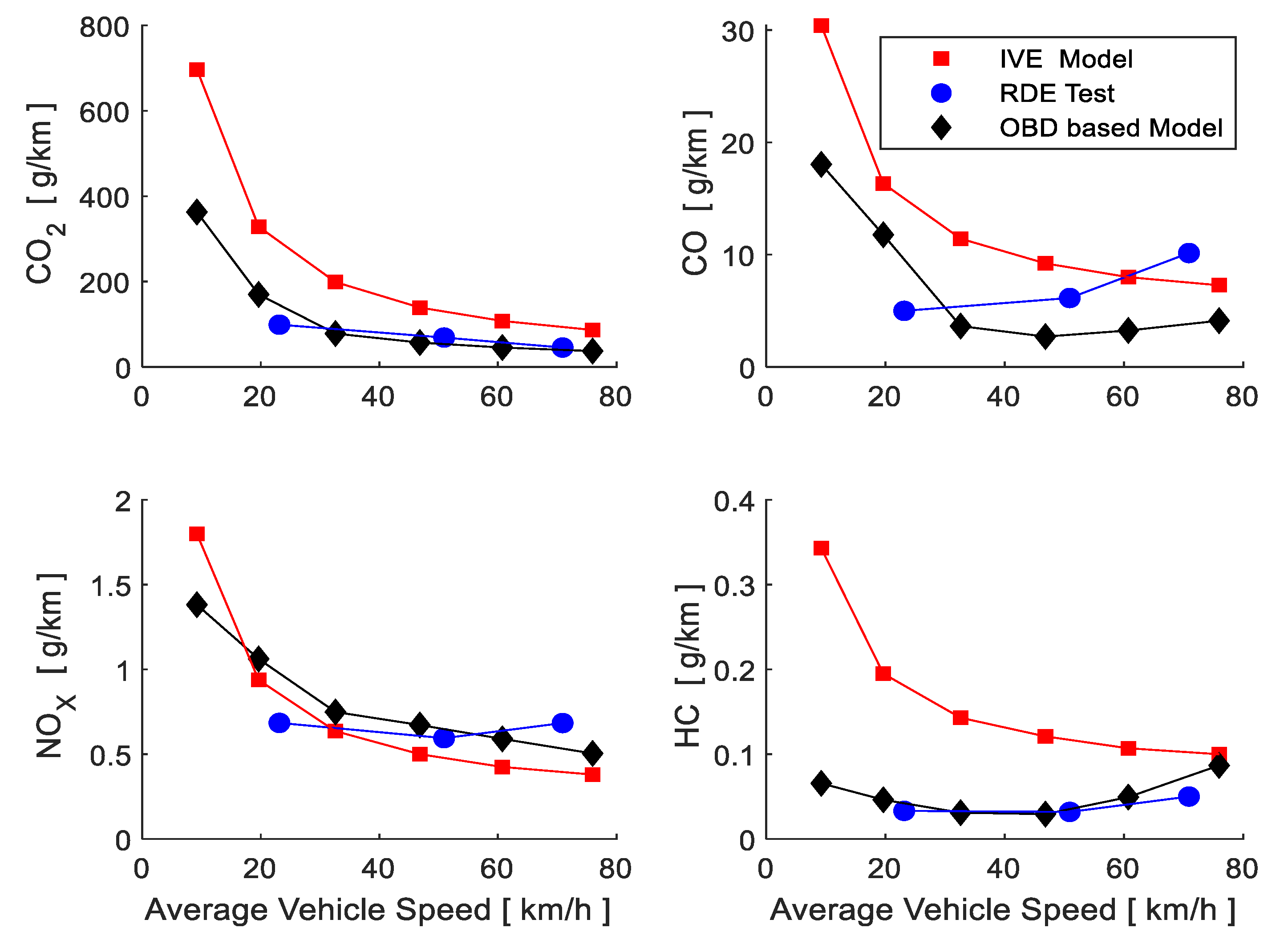
| Parameter | Symbol | Min | Max | Unit |
|---|---|---|---|---|
| Throttle Position | TPS | 0 | 100 | [%] |
| Mass Air Flow | MAF | 0 | 655.35 | [g/s] |
| Manifold Absolute Pressure | MAP | 0 | 255 | [kPa] |
| Intake Air Temperature | IAT | −40 | 215 | [°C] |
| Engine Coolant Temperature | ECT | −40 | 215 | [°C] |
| Vehicle Speed | VSS | 0 | 255 | [km/h] |
| Engine Speed | RPM | 0 | 16,383.75 | [RPM] |
| Acceleration | ax | - | - | [m/s2] |
| Fuel flow | ff | 0 | 120 | [l/h] |
| Latitude | Lat | - | - | [°] |
| Longitude | Long | - | - | [°] |
| Altitude | Alt | - | - | [m] |
| RDE Trip Characteristics | Route 1 | Route 2 | RDE Trip Requirements | Unit |
|---|---|---|---|---|
| Sample number | 85,697 | 73,422 | - | - |
| Total distance | 62.49 | 55.41 | - | [km] |
| Total duration | 96.99 | 81.88 | 90–120 | [min] |
| Urban distance | 21.63 | 17.87 | >16 | [km] |
| Rural distance | 21.24 | 18.77 | >16 | [km] |
| Motorway distance | 19.61 | 18.76 | >16 | [km] |
| Urban distance share | 34.61 | 32.25 | 29–44 | [%] |
| Rural distance share | 34.01 | 33.87 | 23–43 | [%] |
| Motorway distance share | 31.38 | 33.88 | 23–43 | [%] |
| Urban average speed | 22.49 | 23.14 | - | [km/h] |
| Rural average speed | 50.14 | 50.91 | - | [km/h] |
| Motorway average speed | 85.19 | 70.91 | - | [km/h] |
| Urban idle time | 11.61 | 14.45 | 10–30 | [%] |
| Altitude difference between departure and arrival | −4.4 | 54 | <100 | [m] |
| F | Urban [g/km] | Rural [g/km] | Motorway [g/km] | Average [g/km] |
|---|---|---|---|---|
| CO2 | 83.78 | 79.20 | 45.57 | 70.23 |
| CO | 2.85 | 6.65 | 6.63 | 5.33 |
| NOX | 0.6694 | 0.8063 | 0.6820 | 0.7199 |
| HC | 0.0314 | 0.0426 | 0.0736 | 0.0485 |
| Gear | Distance [km] | Rate Distance [%] | Time [min] | Rate Time [%] | Average Speed [km/h] |
|---|---|---|---|---|---|
| N | 2.09 | 0.17 | 402.77 | 14.26 | 0.31 |
| 1 | 53.61 | 4.40 | 348.37 | 12.34 | 9.23 |
| 2 | 191.93 | 15.75 | 586.25 | 20.76 | 19.64 |
| 3 | 464.76 | 38.13 | 855.21 | 30.29 | 32.61 |
| 4 | 284.71 | 23.36 | 364.77 | 12.92 | 46.83 |
| 5 | 119.88 | 9.84 | 118.41 | 4.19 | 60.74 |
| 6 | 101.92 | 8.36 | 80.5 | 2.85 | 75.97 |
| F | IVE [g/km] | RDE [g/km] | OBDM [g/km] |
|---|---|---|---|
| CO2 | 208.97 | 70.23 | 111.47 |
| CO | 11.83 | 5.33 | 6.04 |
| NOX | 0.661 | 0.7199 | 0.777 |
| HC | 0.1477 | 0.0485 | 0.043 |
| Characteristics | RDE | OBDM | ||||||
|---|---|---|---|---|---|---|---|---|
| Idle | Urban | Rural | Motorway | Idle | Urban | Rural | Motorway | |
| Distance [km] | 0 | 21.63 | 21.24 | 19.61 | 2.09 | 712.39 | 356.63 | 149.87 |
| Rate Distance [%] | 0 | 34.61 | 34.01 | 31.38 | 0.17 | 58.27 | 29.26 | 12.29 |
| Time [min] | 11.26 | 57.7 | 25.41 | 13.81 | 402.77 | 2192.6 | 435.81 | 127.86 |
| Rate time [%] | 11.61 | 50.41 | 22.21 | 11.15 | 14.26 | 79.55 | 15.81 | 4.64 |
| Average Speed [km/h] | 0 | 22.49 | 50.14 | 85.19 | 0.31 | 19.43 | 49.09 | 70.32 |
Publisher’s Note: MDPI stays neutral with regard to jurisdictional claims in published maps and institutional affiliations. |
© 2021 by the authors. Licensee MDPI, Basel, Switzerland. This article is an open access article distributed under the terms and conditions of the Creative Commons Attribution (CC BY) license (https://creativecommons.org/licenses/by/4.0/).
Share and Cite
Rivera-Campoverde, N.D.; Muñoz-Sanz, J.L.; Arenas-Ramirez, B.d.V. Estimation of Pollutant Emissions in Real Driving Conditions Based on Data from OBD and Machine Learning. Sensors 2021, 21, 6344. https://doi.org/10.3390/s21196344
Rivera-Campoverde ND, Muñoz-Sanz JL, Arenas-Ramirez BdV. Estimation of Pollutant Emissions in Real Driving Conditions Based on Data from OBD and Machine Learning. Sensors. 2021; 21(19):6344. https://doi.org/10.3390/s21196344
Chicago/Turabian StyleRivera-Campoverde, Néstor Diego, José Luis Muñoz-Sanz, and Blanca del Valle Arenas-Ramirez. 2021. "Estimation of Pollutant Emissions in Real Driving Conditions Based on Data from OBD and Machine Learning" Sensors 21, no. 19: 6344. https://doi.org/10.3390/s21196344
APA StyleRivera-Campoverde, N. D., Muñoz-Sanz, J. L., & Arenas-Ramirez, B. d. V. (2021). Estimation of Pollutant Emissions in Real Driving Conditions Based on Data from OBD and Machine Learning. Sensors, 21(19), 6344. https://doi.org/10.3390/s21196344






